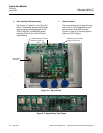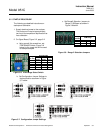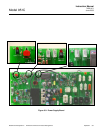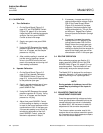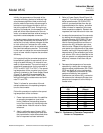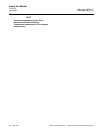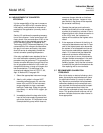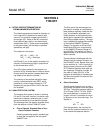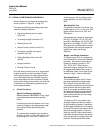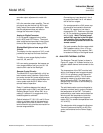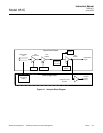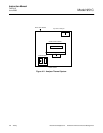
Instruction Manual
748214-V
June 2009
Rosemount Analytical Inc. A Division of Emerson Process Management Operation 3-9
Model 951C
3-6 MEASUREMENT OF CONVERTER
EFFICIENCY
It is the responsibility of the user to measure
efficiency of the NO
2
-to-NO converter during
initial startup, and thereafter at intervals ap-
propriate to the application (normally once a
month).
Section 3-5 optimizes the operating tempera-
ture of the converter. It also serves as an effi-
ciency check if the concentration of NO
2
in the
calibration gas is documented accurate rela-
tive to National Institute of Standards and
Technology (NIST) Reference Materials. If the
concentration of the nitrogen dioxide calibra-
tion gas is not known accurately, this proce-
dure still serves to adequately provide the
correct converter operating temperature.
If the only available known standard is the ni-
tric oxide calibration standard, the following
procedure may be performed. This procedure
checks converter efficiency through the utiliza-
tion of gas-phase oxidation of nitric oxide into
nitrogen dioxide over a range of nitrogen diox-
ide concentrations. This technique is ab-
stracted and adapted from 40 CFR, Pt. 60,
App. A, Method 20, Paragraph 5.6.
1. Select the appropriate instrument range.
2. Admit a nitric oxide in nitrogen NIST
traceable calibration gas of a value be-
tween 45% and 55% of the instrument
range selected to a clean, evacuated,
leak tight Tedlar bag. Dilute this gas ap-
proximately 1:1 with a 20.9% oxygen, pu-
rified air.
3. Immediately attach the bag outlet to the
input of the pump supplying pressurized
gas to the analyzer. It is important to use
a sample delivery pump which does not
consume nitrogen dioxide as it delivers
sample to the analyzer. Losses of nitro-
gen dioxide in the pump will be reported
as converter inefficiency.
4. Operate the analyzer and continue to
sample the diluted nitric oxide sample for
a period of at least thirty minutes. If the ni-
trogen dioxide to nitric oxide conversion is
at the 100% level, the instrument re-
sponse will be stable at the highest value
noted.
5. If the response at the end of the thirty mi-
nute period decreases more than 2.0 per-
cent of the highest peak value observed,
the system is not acceptable and correc-
tions must be made before repeating the
check. If it is determined that observed
subnormal conversion efficiencies are
real, and not due to errors introduced by
nitrogen dioxide consumption in the sam-
ple pump or other parts of the sample
handling system, verify that the converter
is peaked at the optimum temperature be-
fore replacing with a new converter.
3-7 RECOMMENDED CALIBRATION
FREQUENCY
After initial startup or startup following a shut-
down, the analyzer requires about two hours
for stabilization before it is ready for calibra-
tion. Maximum permissible interval between
calibrations depends on the analytical accu-
racy required, and therefore cannot be speci-
fied. It is recommended that initially the
instrument be calibrated at least once every 8
hours. This practice should continue until ex-
perience indicates that some other interval is
more appropriate.




